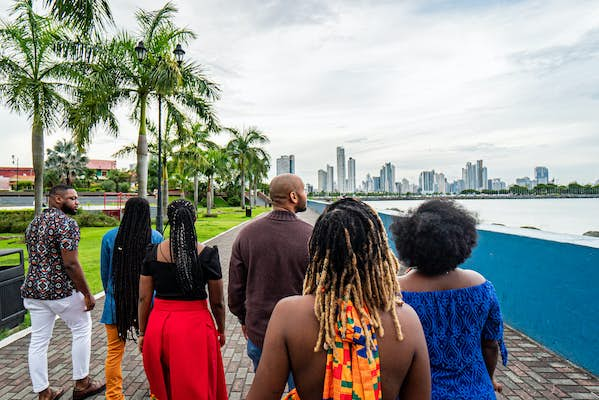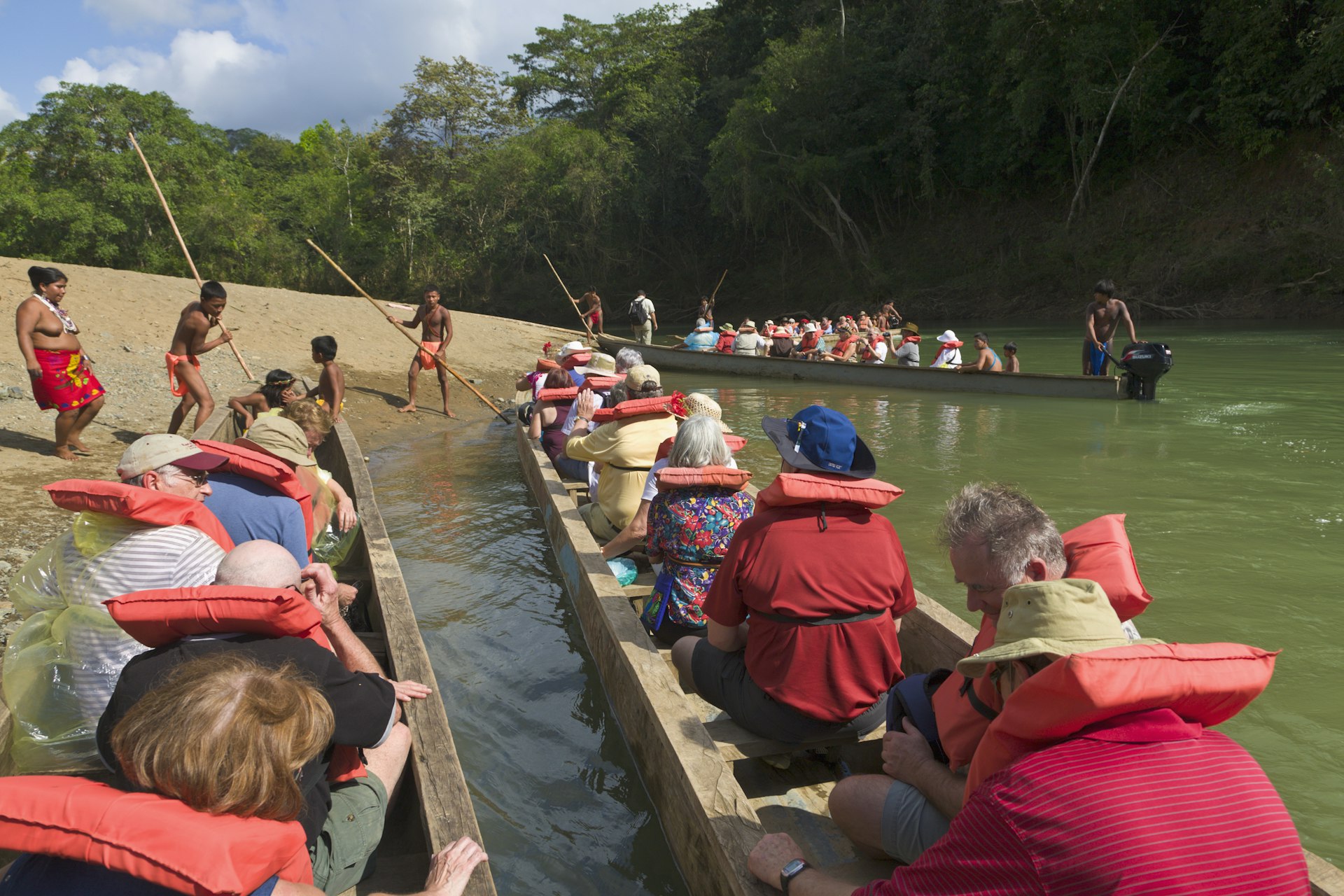Getting around in Panama – Lonely Planet
6 min read
The breadth of Panama is so slender you can cross it in about an hour by car, but that doesn’t mean this Central American gem isn’t packed full of attractions. It’s one of the most biologically diverse places on earth, yet small enough to fit inside the state of South Carolina.
Despite the tropical setting, getting around Panama is easy enough. The country boasts thousands of kilometers of paved roads, a modern bus network, water taxis, an innovative new Metro train in the capital – and, of course, the Panama Canal.
But be aware: some parts of Panama are so remote that your only option may be to travel down a crocodile-infested river in a rickety canoe or hack through the undergrowth with a machete.
Whether you choose to play it safe or go wild, here’s our guide to getting around Panama.
Buses are best
Panama has an affordable and extensive bus network connecting all major mainland destinations. Most intercity buses are 28-seat Toyota Coasters with icy air-conditioning and raucous salsa music.
Bulky luggage is strapped to the roof, and there’s an assistant called a pavo (literally, “turkey”) to collect fares and help out. The long-distance buses connecting Panama City and David are the best in Central America.
You’ll also find chivas – converted cattle or pickup trucks – with hard benches and tarpaulin coverings to keep off the rain. Chivas are typically only seen on the most remote rural routes.
Then there are diablo rojos (red devils) – old US school buses, also known as “chicken buses” – glammed up with neon lights and gaudy artwork. Chicken buses have been pretty much phased out in Panama City but continue to operate in a few areas, including along the central Caribbean Coast.
Most towns and cities have a downtown terminal. Elsewhere, buses pick up and drop off passengers at concrete shelters on the roadside. Stick out your thumb to flag down a passing bus, and yell “parada” (stop) when you want to get off.
Tips for getting a bus out of Panama City
In Panama City, intercity buses depart from the large La Gran Terminal Nacional de Transporte de Panamá in Albrook – a modern, well-designed terminal with a shopping mall and a Metro station attached.
Every bus route has its own dedicated ticket window. Consult the terminal website for the route operator’s name, telephone number and ticket office number. To pass through the turnstiles to the departure gates, you must pay a US$0.10 tax using the “3-in-1” Rapi-Pass card (no cash).
Purchase the card on arrival at Tocumen Airport or from a Metro station – you can also use it to pay for travel on Metrobuses and trains.
Tips for catching the bus across Panama’s borders
Ticabus is the main international carrier operating international bus services to San José in Costa Rica and beyond.
It takes 16 to 18 hours by bus to travel from Panama City to San José; international buses typically take 1 to 2 hours to complete customs and immigration formalities at the Paso Canoas border crossing.
If you’re traveling light, it’s quicker to hop between local buses for the trip to San José. Take a local service from the bus terminal in David to Paso Canoas/Frontera (or Puerto Armuelles); from here (or from nearby Ciudad Neily), long-distance Costa Rican buses connect to San José.
Note that the coastal highway through Costa Rica is 4 to 5 hours quicker than the (stunning) mountain route on the old Panamerican Highway, so choose your bus route wisely.

Explore Panama’s rainforest rivers by piragua
Where roads are lacking, dug-out riverboats known as piraguas (or cayucos) are used. Customarily carved from the trunk of a giant ceiba tree, piraguas are commonly found on the jungle-shrouded waterways of mainland Bocas del Toro and Darién Province.
The boats are traditionally punted with long sticks, but outboard motors are becoming increasingly popular.
Hiring an entire boat with a driver is not cheap, and the price will depend on the distance you plan to cover, the weight of the cargo, the number of passengers, the engine type and the fuel used. As a rough guide, expect to pay USD$100 to US$250 per day.

Pangas, ferries, yachts and the Panama Canal
Motor-powered canoes are widely used to get between offshore islands in Comarca de Guna Yala. For sea travel almost everywhere else, take a panga – a long, sturdy, open-hulled skiff with space for a dozen or more passengers and luggage.
The Bocas del Toro archipelago is also served by a fleet of high-powered pangas that whizz between the islands and shuttle travelers to and from the mainland port of Almirante.
In addition, there’s a daily car ferry, although only Isla Colón has paved roads. Conventional ferries connect Panama City with Taboga island and the Pearl Islands.
Yachts frequently travel to Colombia via the Caribbean Sea; many have space for passengers and crew, but always properly vet the captain and vessel before committing to a trip. Hostel noticeboards often advertise their services.
Full and partial transits of the canal are also possible with Panama Marine Adventures.

Hire a car to explore at your leisure
Driving in Panama City is a logistical horror show, but there are many fine road trips throughout the rest of the country. Most major roads are paved, but not necessarily well-maintained.
Car rental agencies are widespread in Panama City and David; you’ll pay upward of US$35 per day for a small vehicle. You’ll need a 4WD to get off the beaten track, especially during the wet season (April to December), when there’s a heightened risk of landslides and floods.
Multi-lane highways connect Panama City with Colón, and you can cross from the Pacific to the Caribbean Sea in about an hour when the traffic is clear.
In western Panama, a winding transisthmian highway connects Chiriquí Province with Bocas del Toro Province, passing through spectacular scenery as it crosses over the continental divide.
The Panamerican Highway is the nation’s principal road artery, but it’s only paved as far as Yaviza in the east. The lawless forests of the Darién Gap are a no-go area for travelers, and the police will detain you if you attempt to cross into Colombia.
Maybe skip that expensive domestic flight
Domestic flights are comparatively expensive, and they carry a hefty carbon footprint, too. Panama is compact enough to get around by bus, and there are just a few remote regions that can only be accessed by plane.
Air Panama operates flights to every corner of Panama, including Darién, Guna Yala, the Pearl Islands, the Azuero Peninsula, Chiriquí and Bocas del Toro. Domestic flights depart from Albrook “Marcos A Gelabert” International Airport, 3.5km (2.2 miles) from Albrook bus terminal. Take a taxi to get there.
Accessible transportation in Panama
Unlike neighboring Costa Rica, Panama is not a big destination for agencies specializing in excursions for persons with disabilities. Beyond Panama City, there’s little infrastructure for wheelchair users, and even in the capital, the terrible condition of the sidewalks makes getting around a challenge.
Many large hotels and resorts are equipped with ramps and grab rails, and many attractions are wheelchair-friendly, but long-distance buses don’t have much space.
Hiring a vehicle may be the easiest option. For more information on accessible travel, see Lonely Planet’s Accessible Travel Resources.





